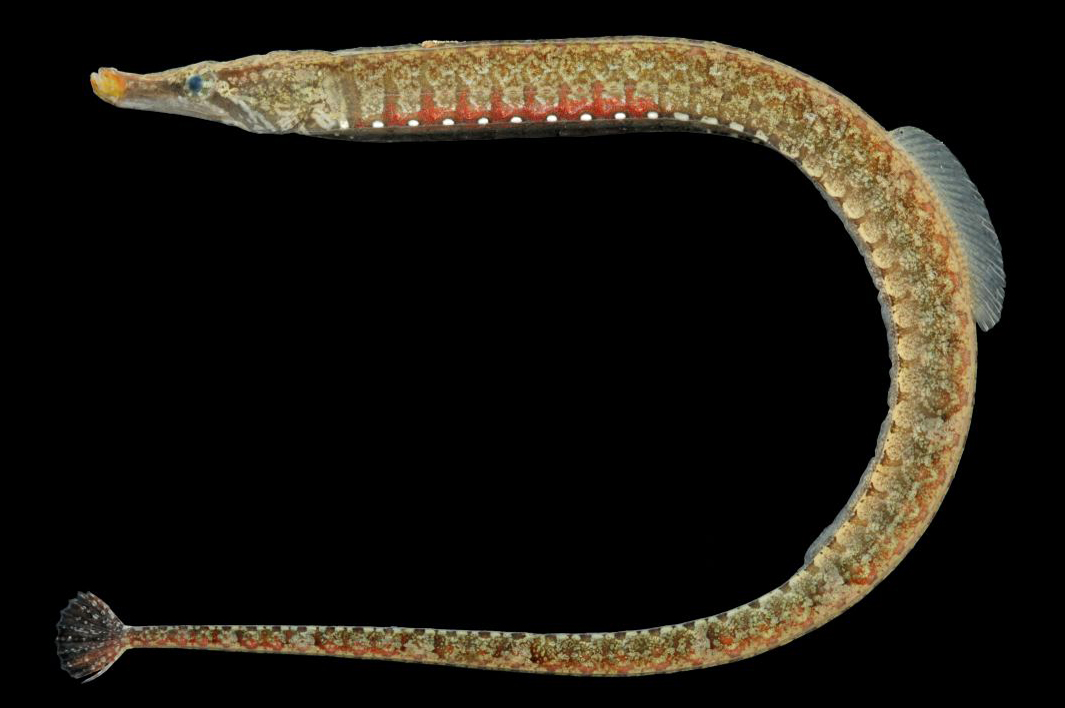Madura Pipefish, Hippichthys heptagonus Bleeker 1849

Madura Pipefish, Hippichthys heptagonus. Source: Dinh D. Tran, FiMSeA / http://ffish.asia. License: CC by Attribution
A brownish pipefish, often with alternating dark and light bands or saddles along the back and upper sides, a black stripe on the side of the snout, and a pair of sloping black bands radiating from the rear of the eye.
The Madura Pipefish inhabits brackish mangrove areas, tidal creeks, and the lower reaches of freshwater streams and rivers.
Madura Pipefish, Hippichthys heptagonus Bleeker 1849
More Info
|
Distribution |
Widespread in the tropical Indo-West Pacific, from East Africa to Melanesia and north to Japan; inhabits inshore mangrove estuaries, tidal creeks and the lower reaches of freshwater streams. |
|
Features |
Dorsal fin 23-30; Pectoral fin 13-16 (usually 15); Trunk rings 14-15; Tail rings 36-42. Head length 8.6-12.7 in SL; snout relatively short, 1.9-2.8 in head length; snout depth 2.6-4.4 in snout length; inferior trunk and tail ridges continuous; scutella not keeled; lateral snout ridge distinct in most subadults and adults. Pectoral-fin base not strongly protruding laterally, crossed by two low ridges; dorsal fin origin from posterior fourth of last trunk ring to posterior margin of 1st tail ring; dorsal fin base not elevated; dorsal fin membrane closely bound to fin rays; anal fin narrow. |
|
Size |
To 15 mm. |
|
Colour |
Generally brownish, often with alternating dark and light bands or saddles along the back and upper sides; black stripe on side of snout and a pair of sloping black bands radiate from the rear of the eyes. |
|
Feeding |
Preys mostly on tiny planktonic crustaceans (especially copepods), and on aquatic insect larvae, other small crustaceans (such as cladocerans) and unsegmented worms (such as nematodes and flatworms). |
|
Biology |
Males brood the eggs in a brood pouch under tail. The pouch has protective plates and an everted pouch closure. Males may begin brooding at 65-75 mm SL. Brood pouch eggs are oval in shape and crowded in up to 10-11 transverse rows (typically in a single layer) across the upper part of the pouch folds and dorsal surface of the pouch. The eggs are in a continuous gelatinous matrix but are covered by protective folds which meet or overlap on the ventral midline. |
|
Conservation |
IUCN Red List: Least Concern. Hippichthys heptagonus is a listed Marine species under the Environment Protection and Biodiversity Conservation Act 1999 (EPBC Act 1999 Marine Species). |
|
Remarks |
Further research may reveal that this widespread species is actually a species complex. |
|
Similar Species |
H. heptagonus is most readily separated from other members of teh genus Hippichthys by the absence of a longitudinal ridge on the scutella, a prominent lateral snout ridge and the dorsal fin usually originating in front of the 2nd tail ring. At lengths above 70 mm, the head is relatively shorter than that of H. spicifer or H. cyanospilus. |
|
Etymology |
Hippichthys is from the Greek ippos meaning horse and the Greek ichthys for fish. |
|
Species Citation |
Hippichthys heptagonus Bleeker 1849, Verh. Bat. Gen. 22: 15. Type locality: Indonesia. |
|
Author |
Vanessa J. Thompson & Dianne J. Bray |
Madura Pipefish, Hippichthys heptagonus Bleeker 1849
References
Allen, G.R. 1991. Field guide to the freshwater fishes of New Guinea. Publication No. 9, Christensen Research Institute, Madang, Papua New Guinea. 268 pp.
Allen, G.R., S.H. Midgley & M. Allen. 2002. Field Guide to the Freshwater Fishes of Australia. Western Australian Museum, Perth.
Bleeker, P. 1849. Bijdrage tot de kennis der ichthyologische fauna van het eiland Madura, met beschrijving van eenige nieuwe species. Verh. Bat. Gen. 22: 1-16.
Dawson, C.E. 1978. Review of the Indo-Pacific fish genus Hippichthys (Syngnathidae). Proc. Biol. Soc. Wash. 91(1): 132-157.
Dawson, C.E. 1985. Indo-Pacific Pipefishes (Red Sea to the Americas). Gulf Coast Research Laboratory, Ocean Springs, Mississippi. 230 pp.
Dawson, C.E. 1986. Syngnathidae. p. 445-458. In Smith M.M. & P.C. Heemstra (eds.) Smiths' sea fishes. Springer-Verlag, Berlin.
Department of the Environment, Water, Heritage and the Arts (2008). Hippichthys heptagonus in Species Profile and Threats Database, Department of the Environment, Water, Heritage and the Arts, Canberra. Available from: http://www.environment.gov.au/sprat. Accessed 2008-03-12@10:45:19.
Heemstra, P.C. & E. Heemstra. 2004. Coastal Fishes of Southern Africa. NISC and SAIAB. 488 pp.
Hoese, D.F., D.J. Bray, J.R. Paxton & G.R. Allen. 2006. Fishes. In Beesley, P.L. & A. Wells (eds). Zoological catalogue of Australia. Volume 35. ABRS & CSIRO Publishing: Australia. 2178 pp.
Jenkins, A.P. & Mailautoka, K. 2010. Hippichthys albomaculosus, a new species of freshwater pipefish (Pisces: Syngnathidae) from Fiji. aqua, International Journal of Ichthyology 16(3): 111-116.
Jenkins, A., Kullander, F.F. & Tan, H.H. 2009. Hippichthys heptagonus. The IUCN Red List of Threatened Species. Version 2015.2.
Jones, A., Rudstam, L. & Rayner, T. 2007. Natural Diet of an Australian Freshwater Pipefish. Available from Nature Precedings http://dx.doi.org/10.1038/npre.2007.329.1
Kawanabe, H. & N. Mizuno. 1989. Freshwater Fishes of Japan. Yama-Kei Publishers, Tokyo. 719 pp. [In Japanese.]
Kottelat, M., A.J. Whitten, S.N. Kartikasari & S. Wirjoatmodjo. 1993. Freshwater fishes of Western Indonesia and Sulawesi. Periplus Editions, Hong Kong. 221 pp.
Kuiter, R.H. 2000. Seahorses, Pipefishes and their Relatives. TMC Publishing, Chorleywood, UK. 240 pp.
Nakabo, T. 2002. (ed.) Fishes of Japan with pictorial keys to the species. English edition. Tokai University Press. vol. 1, 866 pp.
Paulus, T. 1999. Family Syngnathidae. pp 2264-2276, In Capenter K.E. & Niem V.H. (eds) The Living Marine Resources of the Western Central Pacific. FAO Species Identification Guide For Fisheries Purposes. FAO Vol. 4. pp 2069-2790.
Pogonoski, J.J., D.A. Pollard & J.R. Paxton. 2002. Conservation Overview and Action Plan for Australian Threatened and Potentially Threatened Marine and Estuarine Fishes, Environment Australia, Canberra. 375 pp. Available online at: http://www.environment.gov.au/coasts/publications/marine-fish-action/index.html
Talwar, P.K. & A.G. Jhingran. 1991. Inland fishes of India and adjacent countries. Volume 2. A.A. Balkema, Rotterdam.


